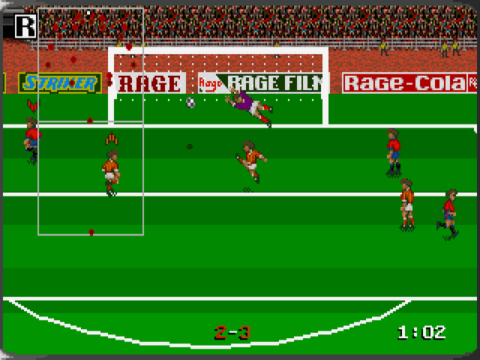
Striker
Written by: Rik
Date posted: February 25, 2016
- Genre: Sport
- Developed by: Rage Software
- Published by: Rage Software
- Year released: 1993
- Our score: 6
The early nineties were a great time to be alive if you were a fan of mediocre football games. Far from the two-horse race the current market has become, anyone was free to have a go, with dozens of titles jostling for attention, usually with a particular quirk or unique feature that could be used as a selling point. Altering the viewing angle was one way to go, and so for a period we had a number of games that adopted a strange running-towards-the-goal angle, almost like (if you were a despicable marketing type) actually being on the pitch! At least during the half when you were shooting upfield. After that, it was a bit like watching a match from behind the goal.
Super Soccer on the SNES was the first game I remember adopting this view, although certainly others had tried it before then, with Microstyle’s International Soccer Challenge being a particularly dreadful effort. When Striker was released, though, it was briefly championed as one of the premier football titles around, and a potentially suitable alternative to FIFA and Sensible Soccer.
A fast-paced knockabout with occasional ludicrous moments, Striker certainly delivers end-to-end action, with 2-minute halves being more than sufficient for goals aplenty [now who’s talking like a despicable marketing type – FFG reader]. It’s not the most subtle of interpretations of the real-life sport, with the emphasis being on carefree slide tackles, long mazy runs, and hammering shots at goal at every opportunity. Drawn matches are rare, and effective defending is tricky, and as control of your defensive line is ceded to the AI until called upon, you frequently spy your back four (or back three, if you’re that way inclined) retreating deep into your own penalty area to await the inevitable next attack.
Still, attempting nuance and subtlety, while admirable, is not necessarily all that successful in the world of the one button joystick, and, like its most successful 90s counterparts – Kick Off, Goal! or (if you like it) Sensible Soccer – Striker’s simplicity has helped it age relatively gracefully. Adopting the attack-attack-attack mentality required of you is rather liberating, and a reasonable amount of variety in your play is possible. Dribbling into the area for a shot, or down the flanks for a cross, are the two most effective methods of creating chances, and having one button for all actions means headers (which I found particularly satisfying) and volleys can be performed instinctively. Kick Off and Sensible Soccer fans may decry the sticky-feet nature of the ball control, but it’s not completely forgiving of sharp changes in direction, and you can run the ball out of play.
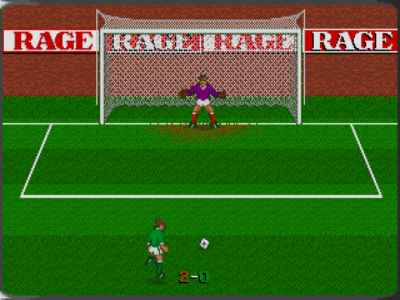
It’s not quite up there with having working windscreen wipers in a driving game, but I love it when the view switches for penalty kicks.
As was the trend in those days, international teams are the only ones featured, although you can put them into a domestic-style league competition, if you want to create a tournament that never existed and never will. Limited tactical tinkering is permitted: you can change formation and swap players, although it’s not obvious from the team select screen which players are playing in which position, and so it’s best not to change too much lest your ponderous centre-back accidentally end up on the wing. Real names are used, with a degree of accuracy, although by default Tony Daley starts up front in the England team and is good at headers. There’s no performance monitoring, though, either for your own team or across the tournament, not even a list of top goalscorers (although, again, this wasn’t unusual for the time).
On the negative side, as we mentioned, defending is pretty hit and miss, and matches tend to be quite one sided, so you can win one match 9-0 and then be thrashed by five goals in the next one. When the better teams get on top of you, it can get a bit frustrating: one particular flaw is that it’s rather hard to clear the ball out of defence, particularly when the goalkeeper has the ball in hand. I never understood in old footy games why you’d be given precise control over goal kicks but not when your goalie picks the ball up, and that’s the case here.
So with the ball on the ground you can minimise trouble by aiming a kick, with some precision, out wide, but if he picks it up from open play, you pretty much have to punt it into midfield where the opposition will inevitably retrieve possession. You can get lucky and win these matches sometimes, but in a league format the very top teams tend to win almost every game, so it’s not really enough. Or maybe I just wasn’t very good at the game, I don’t know.
As previously noted, Striker’s distinctive viewing position isn’t great when you’re attacking into the screen – i.e. with your own players running towards you. Although there is a pitch radar, when you actually get into the area it’s hard to see what’s going on. This can be compounded when you’re playing a team in similar colours: although each side does have a defined second/away kit the game isn’t very sensitive to colour clashes, and will only make a change if the exact same colours are used. Playing as Holland, orange plays red was a frequent problem – as much on the radar as it was on the pitch.
Presentation is very simple – the graphics are slightly dinky but generally ok, with the stripey pitch a little wobbly at times, like the scrolling road of a late 80s racing game. It’s also noticeable that, as with many other football games of the time, all of the players are white, even if you’re playing as, say, Nigeria, which just seems really wrong now. (Again credit must go here to Sensible Soccer, which actually made some effort in this area and certainly is strong evidence against the ‘technical limitations of the time’ argument). The sound is very sparse, with the referee’s whistle sounding a bit like it belongs to a cartoon train: a fairly catchy menu tune is pretty much the only saving grace.
Striker is not without flaws, or the most subtle of games, but it remains very playable. I’d say it belongs to a select group of early 90s football titles that still hold up pretty well.

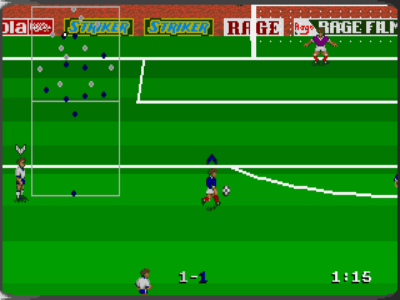
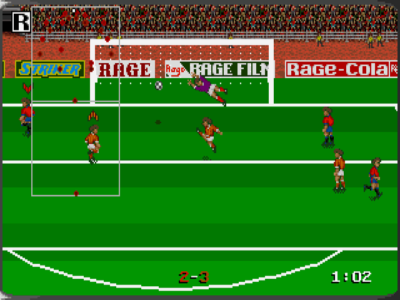
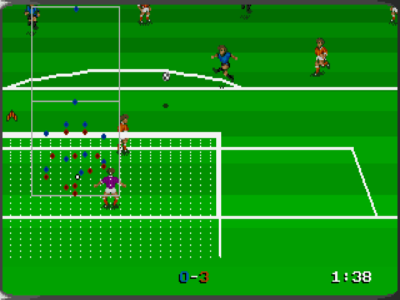

 Posts
Posts